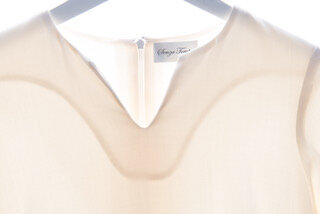
Want A More Sustainable Closet? Shop Like Your Grandmother
If my grandmother was still alive and I tried to explain “sustainable living” to her, she would simply call it living. For her, frugality and minimalism was a way of life.
In today’s consumerist culture, we have too much of everything. We can buy whatever we want to arrive on our doorstep in days. And nowhere is our excessive consumption more obvious than when it comes to our closet.
Yet we can take steps towards a more simple, sustainable quality wardrobe by shopping a little more like previous generations. Here are a few guidelines to help you get started!
1. Good quality & brand names are not equal
My grandmother’s philosophy when it came to clothing was to buy the best you can afford so that it will last. In her day, quality and price were directly correlated. Well-made items were simply more expensive. Clothing in general was expensive for our grandparent’s generation. The average household spent nearly 17% of their income on clothing post WWII. Today we spend less than 3%.
Our grandmothers often bought their clothing from local boutiques that made items specifically for their towns or cities. The price of clothing was a function of the labor and fabric. It didn’t include the marketing costs of public relations, celebrity sponsorships or extravagant fashion shows.
How to determine cheap vs. well-made clothing
The easiest way to understand the quality of a garment is to look inside. Some aspects are easier to see, like the fabric content and hem finishes, while others, like the use of facings and interfacings, aren’t as obvious. These details are where many clothing companies cut corners.
Fabric content
-
Anything synthetic is sub-par as most are plastic derivatives and wear out faster.
-
Natural fabrics like wool, cotton, linen, and silk are superior to synthetics—this includes the lining of the garment.
Hem quality
-
Crooked stitch lines or loose threads on a hem or seam are dead giveaways to poor construction.
-
Hems should be perfectly straight, with a clean finish. Blind hems, where you don’t see the stitching on the outside, are a plus as they are often finished by hand.
These images are examples of straight-stitched hems and finished hems
Facings, interfacings, and linings
-
An interfacing is sewn in between the fabric and lining. Facings are a piece of the outer fabric sewn inside. Both provide structure and strength to the garment and are rarely noted by consumers, making it the easiest step to omit.
-
Linings also help preserve the shape, improve the fit and protect the outer fabric of a garment. Every item shouldn’t have a lining, of course, but anything meant to have a tailored look like a dress or jacket needs a lining.
These images are examples of quality facing on the inside of a garment
2. Shop natural, season-spanning fabrics
My grandmother generally shopped for two seasons: a cold season and a warm season. She had very few elaborate heavy tweeds or gauzy sundresses that can only be worn when it’s extremely cold or extremely hot. Over her lifetime, she lived in places where she experienced both. Instead, her wardrobe consisted of mid-weight wools and wool blends for the colder months, and silks and cottons when it was warm.
Clothing was often lined in silk, a feature reserved for ultra, high-end luxury brands today, but that we still do at Senza Tempo. Silk linings are as practical as they are functional. Silk and other natural fabrics like wool and cotton, are breathable, thus they adjust to your body temperature. It isn’t the wool in your suit that makes you sweat in July, it’s the fact that it’s lined in polyester or acetate which is a derivative of plastic.
3. Focus on classic styles & clean lines
Though most people couldn’t name one item of clothing they kept until it wore out, my grandmother kept her clothing until it couldn’t be repaired or simply wasn’t wearable—in other words, many years. She wore clothing with clean, simple lines in timeless silhouettes. This ethos has been the biggest influence on my personal shopping habits and the philosophy behind my clothing line. The more simple a garment is, the easier it is to accessorize in a variety of ways and wear repeatedly without growing tired of it. Simple styles aren’t boring—they’re versatile.
Even later in her long life, when she had the money to buy whatever she needed and shortages or rations were a thing of the past, she remained thoughtful with her spending especially when it came to clothing. She didn’t buy something just because she liked it or because it was on sale. She bought what she needed. Shopping wasn’t a hobby—she was too busy working, cooking, cleaning, raising kids and, later in life, making time for actual hobbies like traveling with friends and crocheting.
In other words, living.
About The Author
Kristen Fanarakis is the founder of the Los Angeles-made clothing line Senza Tempo, making elevated wardrobe basics for women. She launched Senza Tempo after not being able to find a simple, well-made (yet accessibly-priced) black A-line skirt. Her philosophy of curating your closet, yet never sacrificing style came about while living out of a suitcase traveling for two years. A recovering Wall Street banker and fashion over-consumer, her travels taught her we all need far less than what we have. You can read more about quality clothing and styling wardrobe basics on Senza Tempo’s blog.



